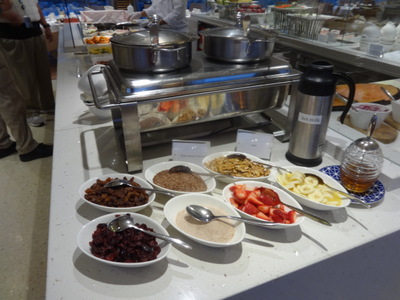
 First Viking breakfast! At the left here, pots of oatmeal and (say what?!) grits! The area in front of them is paved with little dishes of additives including cinnamon sugar but no brown sugar.
First Viking breakfast! At the left here, pots of oatmeal and (say what?!) grits! The area in front of them is paved with little dishes of additives including cinnamon sugar but no brown sugar.Thursday, 22 September, Nikopol, Bulgaria (Veliko Tarnovo & Arbanasi)
Written 2 October 2022

 First Viking breakfast! At the left here, pots of oatmeal and (say what?!) grits! The area in front of them is paved with little dishes of additives including cinnamon sugar but no brown sugar.
First Viking breakfast! At the left here, pots of oatmeal and (say what?!) grits! The area in front of them is paved with little dishes of additives including cinnamon sugar but no brown sugar.
At the right, the smoked salmon service. Each little dish bears a coil of smoked salmon, a dill sprig, a small quenelle of cream cheese, a few capers, a lemon wedge, and a couple of rings of raw red onion. Just right for dressing a quarter of a toasted bagel. I indulged most mornings. A row of bowls offered more of all the toppings.
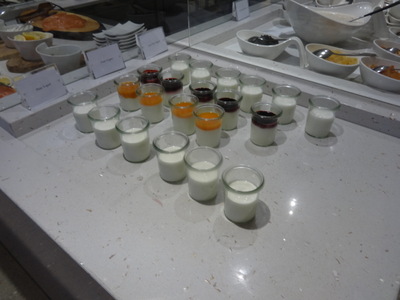
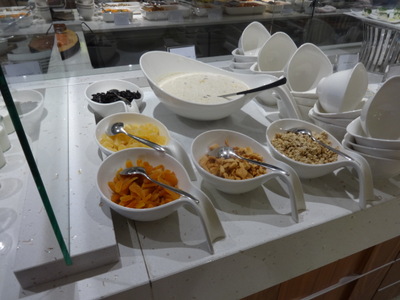 At the left here, yogurts, plain, low fat, and plain topped with the apricot and blueberry preserves made here on board.
At the left here, yogurts, plain, low fat, and plain topped with the apricot and blueberry preserves made here on board.
At the right, ready-mixed muesli with dried plums, pineapple, apricots, apples, and granola to be added ad lib. I think it already had raisins and nuts in it.
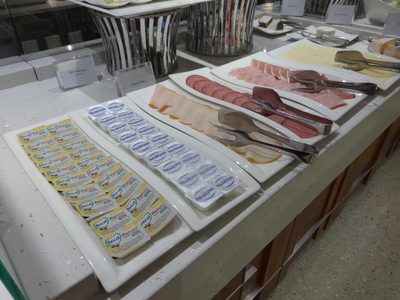
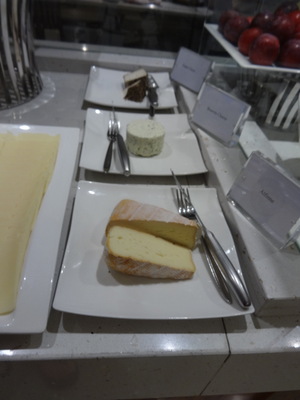 Then came tubs of margarine and cream cheese, three kinds of cold cuts, sliced cheese. At the far end, three whole cheeses: oranged-rinded Alfinne, a cylinder of Boursin, and something called "pepper cheese," which was coated thickly with black pepper.
Then came tubs of margarine and cream cheese, three kinds of cold cuts, sliced cheese. At the far end, three whole cheeses: oranged-rinded Alfinne, a cylinder of Boursin, and something called "pepper cheese," which was coated thickly with black pepper.
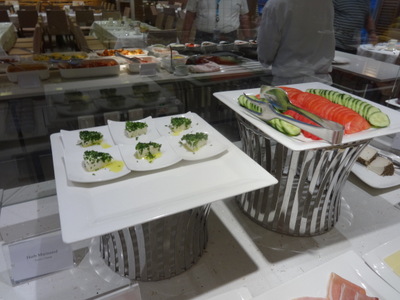 On stands above them were wedges of herb-marinated Sirene, a white, crumbly, slightly sour cheese with parsley heaped on top, and a platter of sliced tomatoes and cucumbers.
On stands above them were wedges of herb-marinated Sirene, a white, crumbly, slightly sour cheese with parsley heaped on top, and a platter of sliced tomatoes and cucumbers.
Written 3 October 2022
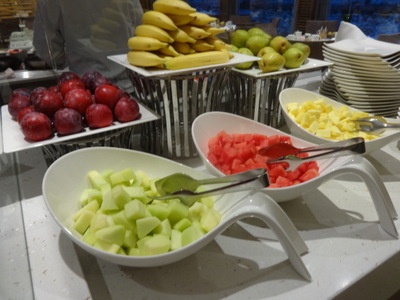
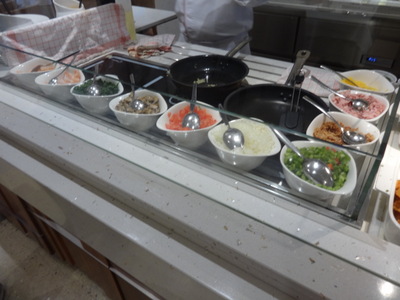 Then the fruit, both cut and whole.
Then the fruit, both cut and whole.
Followed by the eggs-to-order station. The chef on duty there would make you fried eggs in any style or an omelet containing any combination of smoked salmon, shrimp, spinach, mushrooms, tomatoes, onion, peppers, crispy fried onion, ham, and shredded cheddar. Or, I suppose, anything you pulled from elsewhere on the buffet and asked him to add.
If you wanted boiled or poached eggs, eggs benedict, salmon eggs benedict, pancakes (plain or with blueberries, chocolate chips, or bananas), or brioche French toast, you could just tell a waiter, and they have the kitchen whip it up.
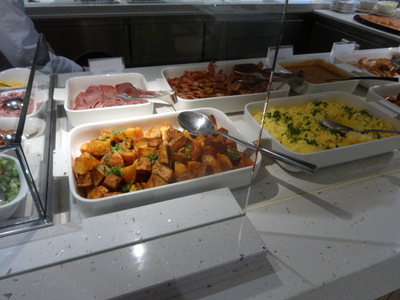
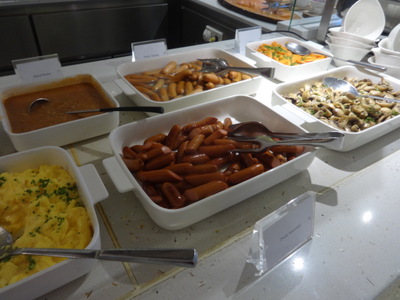 Finally, the hot bar offered Canadian bacon, crispy American bacon, baked beans (we have a lot of Brits and Australians aboard), potatoes (rotating among several preparations), excellent scrambled eggs, poultry sausage (in the back), pork sausage (basically frankfurters on this day, but often something more breakfasty), mushrooms, and cooked vegetable of the day (usually sautéed, on this day carrots, but I've seen baked herbed tomatoes, sweet potatoes, zucchini, eggplant stewed with tomato, even daikon!).
Finally, the hot bar offered Canadian bacon, crispy American bacon, baked beans (we have a lot of Brits and Australians aboard), potatoes (rotating among several preparations), excellent scrambled eggs, poultry sausage (in the back), pork sausage (basically frankfurters on this day, but often something more breakfasty), mushrooms, and cooked vegetable of the day (usually sautéed, on this day carrots, but I've seen baked herbed tomatoes, sweet potatoes, zucchini, eggplant stewed with tomato, even daikon!).
After breakfast, next up was our all-day excursion to Veliko Tarnovo and Arbanasi. We were moored in Romania, so the ship sidled across the river to Nikipol, Bulgaria, to let us disembark and board the buses for the two-hour ride. A ferry also crosses the river at this point, and semi-trucks were queued for a couple of miles by the side of the road waiting to get across. A huge amount of such traffic usually uses Black Sea ferries to reach Bulgaria, but the war in Ukraine is currently limiting that, so they're coming this way instead. Bulgaria has two bridges, one in Russe and the other in Vidin, and Nikopol is one of four or five border control points with ferries. The ferry can ordinarily carry four or five semis at a time, but the low water is limiting them to three (and they don't work at night), making the bottleneck even worse.
Along the way, road signs were in both Cyrillic and Roman alphabets. The guide was very apologetic about a 15-mile stretch of crummy road that we had to travel. Because of flight from the countryside to the cities, villages are inhabited mainly by retirees and don't have the tax base to maintain the roads they're responsible for.
Those villages are a mixture of dilapidation and lovingly groomed gardens. Long rows of houses had beautiful grape arbors along the sides of the road, with ripe grapes on them. At one intersection, a huge dog was lying in the road. Everyone in the bus moaned, thinking he was dead, but as the bus slowly approached, he reluctantly bestirred himself and moved out of our way. Someone asked about the handbills posted on all the telephone and power poles—it turns out they're obituaries! The family posts them for a minimum of 40 days and sometimes for much longer, renewing them as they get weathered.

 Part way to our destination, we stopped for a rest and snack break at this astonishing establishment. On the outside, it's a replica of some famous castle (maybe the one in Veliko Tarnovo), but on the inside it's a dinner theater.
Part way to our destination, we stopped for a rest and snack break at this astonishing establishment. On the outside, it's a replica of some famous castle (maybe the one in Veliko Tarnovo), but on the inside it's a dinner theater.
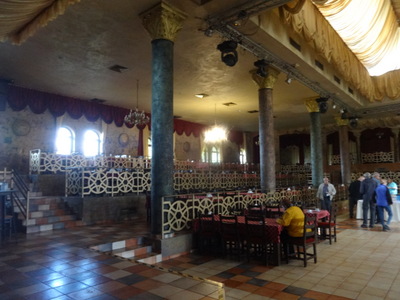 Here are its opulent lobby and, at the right, a shot of the interior, with tables raised on tiers around the open central space. Near the ceiling were lots of theater-style lights and an elaborate speaker system.
Here are its opulent lobby and, at the right, a shot of the interior, with tables raised on tiers around the open central space. Near the ceiling were lots of theater-style lights and an elaborate speaker system.
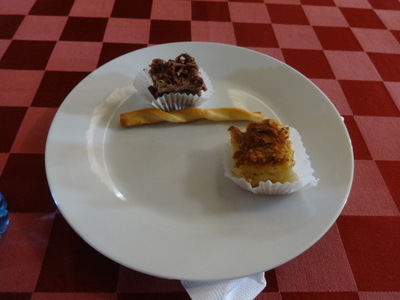
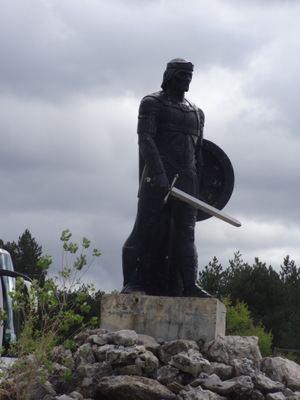 Here's my plate of snacks—in front, a square of savory cheese strudel (a popular Romanian thing), a cheesy bread stick, and in back a square of moist chocolate cake with chocolate filling and chocolate curls on top.
Here's my plate of snacks—in front, a square of savory cheese strudel (a popular Romanian thing), a cheesy bread stick, and in back a square of moist chocolate cake with chocolate filling and chocolate curls on top.
Meanwhile, outside, this impressive larger-than-life knight stood guard.
Back in the buses, we saw modern windmills on the horizon. Some portion of the country's electricity comes from wind power, and some from thermoelectric power, but 60% is from nuclear power. Bulgaria had six reactors. Two were closed down after Chernobyl, then two more as a condition of getting into the EU. But a couple of very large metal-processing plants were closed down after the communists left, so they have excess power. Bulgaria is the largest exporter of electricity to Turkey and Greece in this area.
Along the way, we saw stork's nests on poles. Our guide explained that baby storks are born in Europe, then migrate to Africa. They then stay there three years before coming back for the first time to nest. After that they come back annually with the same mate to the same nest. Elderly birds stay in Europe and are cared for by groups of volunteers.
The guide continued to tell us about Bulgaria. It's about 43,000 square miles and has a 230-mile coastline on the Black Sea. The capital is Sofia, in the central western part of the country (it used to be Veliko Tarnovo). The southwest has ski areas, and the Baltic coast has sea resorts. The country has cold snowy winters because of its continental climate. Winter wheat is the most essential crop, but they also grow maize and other food crops. Bulgaria produces more sunflowers per capita than anybody else in the world. The central valley is the vegetable basket of the country, with thermal heating and greenhouses.
She also mentioned Bulgaria's "Thracian gold," supposedly the oldest in the world and the archeological find of the century. During a war (WWI), it was sent to the protection of the Russian tsar at some point, but he got deposed, so of course it's all still there.
The population is 6.8 million, and 80% of the population are ethnic Bulgarians. I thought she said 86% are orthodox, 20% muslim, and the rest other religions, but that doesn't add up! The official language is Bulgarian (which is slavic). It's spelled very phonetically and uses prepositions, like English, not cases.
Cyril and his brother invented the cyrillic alphabet in Bulgaria. It's the same as the Russian alphabet except that Russian uses one extra letter. Mongolia also uses it, even though it's not a slavic language.
Bulgaria is in both the EU and NATO, but does not use the Euro and is not part of the Schengen treaty. I missed what she said was the average annual income, but I think she said 160 euros is the minimum; 20% live below the poverty line.
Along the roads, I saw a lot of what looked like ripe elderberries. One big flock of swallows with rusty throats were perched on the wires. Also occasional pink mimosas (Albizzias) in bloom, and many of the trees were full of cimbing wild clematis (virgin's bower) in fruit, making the trees look all fuzzy. One great grey heron was standing by a passing pond.
Ahead of the bus, I once saw a couple of largeish brown birds crossing the road on foot; when they took flight, they looked like grouse or partridges! Wish I'd gotten a better look at them.
The guide told us much more, but unfortunately, my notes get a little sketchy, so I'm not sure I can reconstruct it. In the beginning (as we've heard several times from guides in different countries), migrating south slavs broke into three groups, one of which settled around the mouth of the Danube and became Bulgaria. Bulgaria has had three kingdoms, the last of which ended with the current socialist era. The Cyrillic alphabet was invented in the 9th century. Bulgarian nationality began with conversion to Christianity. 889-927 A.D. was the "golden century" of Bulgarian history, during the first kingdom. The first and second kingdoms were separated by a period of Byzantine rule; the second and third by Ottoman rule. Hope I've got that right. The third kingdom was 1878–1944.
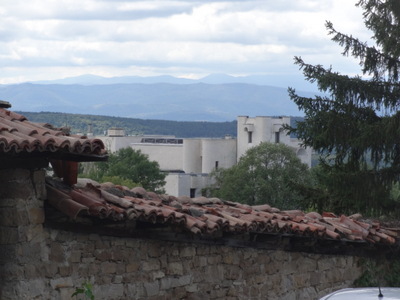
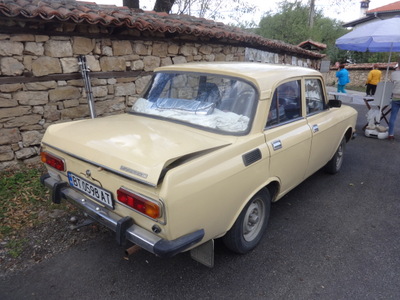 After more scenic time in the buses, we arrived at Arbanasi, a small town near Veliko Tarnovo. It has apparently been a very affluent area since its founding. The white modern building shown here at the left was the summer residence of the communist leader of the country. Now it's a hotel.
After more scenic time in the buses, we arrived at Arbanasi, a small town near Veliko Tarnovo. It has apparently been a very affluent area since its founding. The white modern building shown here at the left was the summer residence of the communist leader of the country. Now it's a hotel.
The little yellow car is a vintage "Moskvitch," made in Russia.
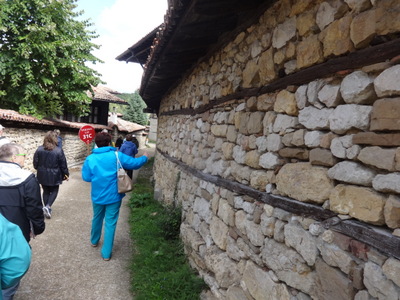 We toured the Nativity church in Arbanasi. It was built under the Ottomans, when no church was allowed to be taller than a Turkish soldier on a horse, any church had to be smaller than the smallest mosque in town.
Unfortunately, photos weren't allowed inside, but it was entirely covered, floor to domed ceiling with frescoes, apparently done by a troop of itinerant artists and painters who traveled the countryside taking on jobs like that. (They passed formulas and recipes down from father to son and only in the 19th century began painting portraits as well.) I can't show the frescoes, but the left-hand photo here shows a feature of the outside. In most of the buildings in the town, wooded courses were included in the stone walls, which made them more stable in earthquakes.
We toured the Nativity church in Arbanasi. It was built under the Ottomans, when no church was allowed to be taller than a Turkish soldier on a horse, any church had to be smaller than the smallest mosque in town.
Unfortunately, photos weren't allowed inside, but it was entirely covered, floor to domed ceiling with frescoes, apparently done by a troop of itinerant artists and painters who traveled the countryside taking on jobs like that. (They passed formulas and recipes down from father to son and only in the 19th century began painting portraits as well.) I can't show the frescoes, but the left-hand photo here shows a feature of the outside. In most of the buildings in the town, wooded courses were included in the stone walls, which made them more stable in earthquakes.
The frescos are from the early 16th century, and the writing in them is in Greek because the Bulgarians were no longer allowed to have their own Patriarch and had to go back to the Greek one. Originally, only the central nave was buit, then in the 17th century, a smaller chapel and a "women's section" (where one would expect a narthex) were aded. In the fresco of the trinity, the father, son, and holy ghost are superimposed and arranged vertically, apparently very unusual for the period. As always, the fresco of the virgin always faces the altar. The iconostasis was made for a larger church and had to be trimmed to fit, so a few of the images were lost. In the images, drapery of white or red cloth was intended to indicate interior scenes, white for day, red for night.
Until fairly recently, all the frescoes were black from long use of candles in the church; they left one as an example and cleaned the others. Cracks and broken places were just plastered up.
A scene that was usually painted on the outside of churches was instead placed in the womens' section. It illustrated the horrible fate of sinners, like people who watered wine, women of easy virtue, women who didn't go to church, etc. A row of martyrs are holding crosses; the saint holding only a hammer and not a cross is the one who protects against contagious disease. The apostles are above the last judgement, whereas the saints are below. Another fresco served as a calendar, and other depicted the ages of man—infant at the bottom, reaching his prime over the top, and deteriorating down the other side. Eventually an annex was added for socializing after services. St. John the baptist (I think?) is the patron saint of the interior chapel used for family events.
From the church, we walked to a house museum. On the way, the guide explained that the town is in "restoration style"—whitewashed, brown wooden joinery, red tile roof. All new building or renovation must conform. The town is a busy resort all year round, and real estate prices are very high, but there are also vacation rentals and resorts.
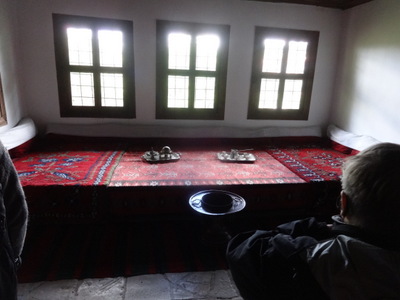
At the right is a room in the house museum. The family that lived there were Christian, but the Ottoman influence is obvious. Every room was configured like this, with a flat platform on which people sat (men crosslegged, women kneeling). This room was the chief reception room of the house. The women's day room had a fur rug on the platform. Servants did the housework, so the women of the family spent their time embroidering and sewing. Various items they would have used were displayed—a flat iron, a spinning wheel, a crank-operated sewing machine, a square embroidery frame.
Off the women's day room was the confinement room. Mothers and their newborns were confined to that room for 40 days, allowed to have contact only with the midwife. At the end of that time, the infant was baptized, and mother and child were allowed to rejoin the family.
Those who made the pilgrimage to Jerusalem could add "Haji" to their names, and I think the guide said the family could then keep the name for six generations.
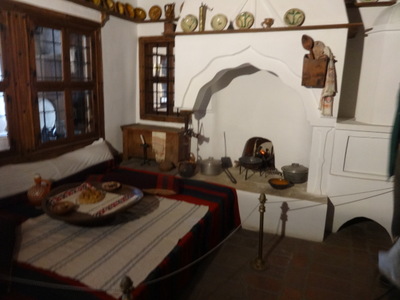
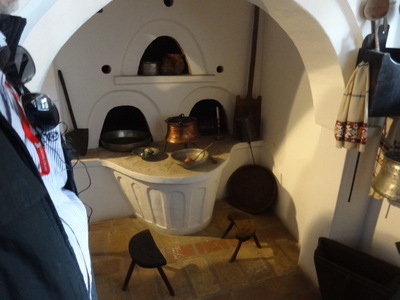 Here are a couple of shots of the kitchen. In the left-hand photo, note the low platform with a low table on it.
Here are a couple of shots of the kitchen. In the left-hand photo, note the low platform with a low table on it.
At the right is the three-compartment oven. The lower right oven was the hottest, used for roasting and baking; the lower left was moderate, used for stewing and braising; and the top one, the coolest was for making yogurt. Yogurt is a very big deal in Bulgaria. Lactobacillus bulgaricus was isolated in the 1930s by a Bulgarian at the Pasteur Institute. It only grows naturally here, perhaps because of what the dairy cows eat or their exposure to cold weather. Bulgarians attribute their great longevity to its properties.
Another thing Bulgaria is known for is the production of the best rose oil in the world. It goes for 6500 to 8000 euros/kg, and it takes 500 to 550 kg of white Damascus roses to produce 1 kg oil; it's boiled and distilled out of them like brandy rather than pressed. Apparently, no perfume can give a lasting aroma without Bulgarian rose oil; it forms the base of most of the highly rated perfumes of the world. It cures headaches when rubbed on the temples, rashes when rubbed on the skin, and is taken internally for stomach trouble.
The roses are grown in a particular valley in the central part of the country. Its high humidity limits evaporation if the aromatics from the roses, which are harvested (always by hand) only for a few hours in the morning (4 to 9:30 am); the rose petals should be dewy to produce the best oil. In the afternoon both quality and quantity drop; the aromatics are drawn back into the plant. The harvest is at the end of May and lasts 3–4 weeks. The scent of the oil is said to last indefinitely. It's exported to Japan, France, and the USA.
Arbanasi is not in the rose growing region, but it has shops selling not just rose oil (at $35/g) but many other products made from the roses—rose jelly, jam, Turkish delight, brandy, and liqueur. We visited such a shop and tasted the last two—the liqueur was better than the brandy (at least to my taste—sweeter and less alcoholic).
From the rose store, we made our way up the street and through the lovely garden courtyard of a resort hotel (complete with fancy chickens and caged peacocks) to their restaurant for lunch.
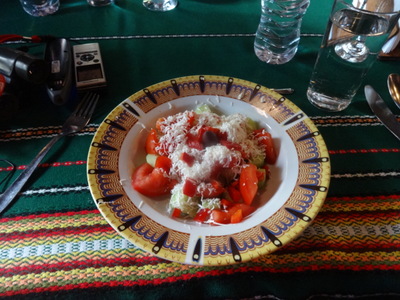
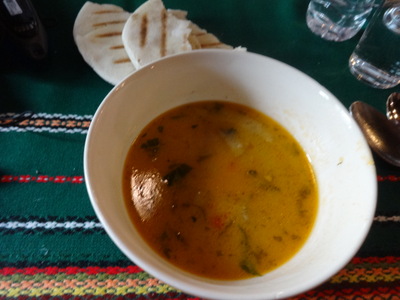 Our guide assured us that Bulgarian "shopska" salad of tomato, cucumber, onion, and a feta-like cow's cheese has been voted the world's best salad. It was very good, but I wouldn't go so far as to say the best.
Our guide assured us that Bulgarian "shopska" salad of tomato, cucumber, onion, and a feta-like cow's cheese has been voted the world's best salad. It was very good, but I wouldn't go so far as to say the best.
The next course, described only as "vegetable soup," was a puréed "potage" style and was excellent. In the background you can see part of a flat disk of fluffy bread with grill marks on it.

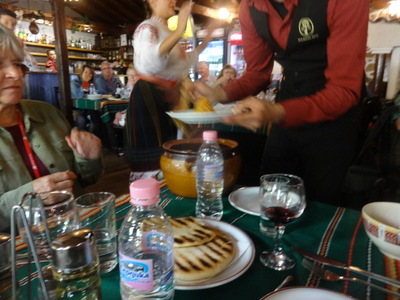 After the soup, musicians and dancers filed in, and during their performance, the main course was served. Here, a waitress scoops it out of a traditional earthenware pot onto our plates. It was made of meat (veal and/or pork?), cabbage, and some other vegetables. I though it was pretty good, but David was less enthusiastic.
After the soup, musicians and dancers filed in, and during their performance, the main course was served. Here, a waitress scoops it out of a traditional earthenware pot onto our plates. It was made of meat (veal and/or pork?), cabbage, and some other vegetables. I though it was pretty good, but David was less enthusiastic.
He did like the wine, which I think he considered the best of the trip so far.
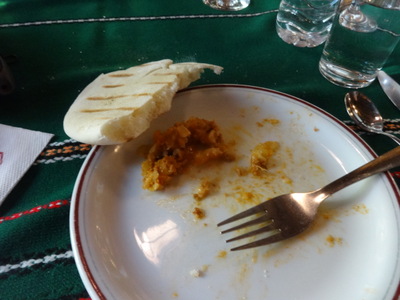
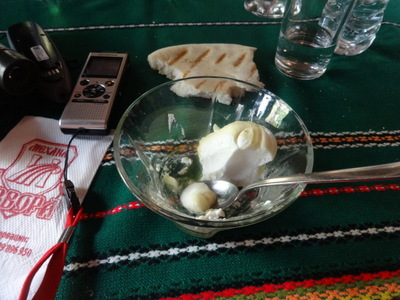 Here's my plate, after I'd eaten most of it. I asked the guide what it was called, and I thought she said "habama," but I can't find anything like that on the internet.
Here's my plate, after I'd eaten most of it. I asked the guide what it was called, and I thought she said "habama," but I can't find anything like that on the internet.
Dessert was the famous Bulgarian yogurt, with honey and crushed walnuts. It was very thick (drained, like Greek, maybe?) and was delicious. When I ran out of honey, I added salt, and it was great that way too!
After lunch, we got back in the bus and headed for Veliko Tarnovo. I spotted one patch of yellow Oenothera blooming by the road, and the fields were dotted with round bales of hay.
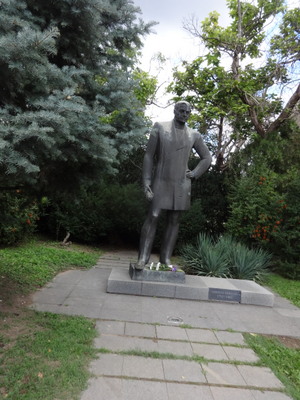
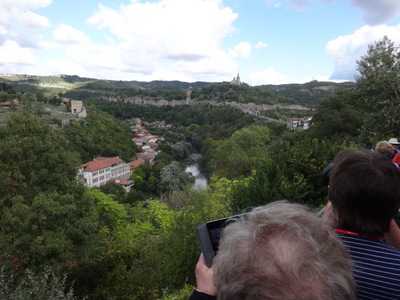 By coincidence, we hit town on Bulgarian independence day, which is a very big deal in Veliko Tarnovo. The place was full of families bringing their kids to see the festivities. The bus dropped us off at a hotel in the middle of town, and we had to walk a good ways downhill to get to good spots for the view of the fortress. On the way, we passed this statue of a major 19th-century benefactor of the town. Partway down the hill, David, reasoning that he didn't feel like climbing all the way back up again, turned back.
By coincidence, we hit town on Bulgarian independence day, which is a very big deal in Veliko Tarnovo. The place was full of families bringing their kids to see the festivities. The bus dropped us off at a hotel in the middle of town, and we had to walk a good ways downhill to get to good spots for the view of the fortress. On the way, we passed this statue of a major 19th-century benefactor of the town. Partway down the hill, David, reasoning that he didn't feel like climbing all the way back up again, turned back.
At the right here is a good view of the fortress. At the lower left part of it, you can see the stone causeway that leads from the cluster of white buildings up to the main gate. Because of the holiday, that causeway was closed at the near end, so we couldn't get any closer to the complex than that. The wall originally ran all the way around the top of the hill, and in addition, the river makes a tight loop around it, so it was pretty hard to attack. I walked all the way to the point where the causeway was blocked, where the ground was littered with TV crews setting up for the evening. I could see that a gate partway across the causeway bristled with fireworks, awaiting nightfall. Guys were setting up metal detectors that would eventually serve as a checkpoint before the current closure.
Arbanasi is on the other side of the hill, behind the fortress, and from some points we could see the modern white building from Veliko Tarnovo.
Its cathedral (left) is dedicated to Saints Constantine and Helena.
The town now manufactures packaging, medical consumables, and beer. It has one of Bulgaria's two military academies; the other is in Sofia. Because of all the students at its schools and universities, it has the lowest average age in Bulgaria.
Gray crows were everywhere, singly and in groups, looking like very dirty magpies. Magnificent stag-horn sumac grew in gardens and sometimes by roadsides.
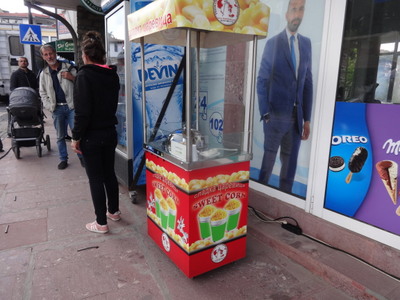
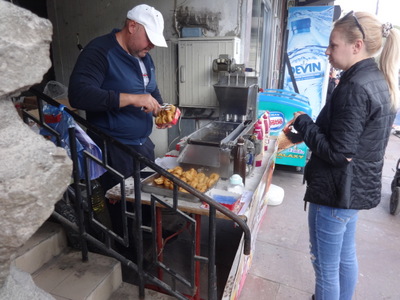 Whole-kernel sweet corn was being sold from carts in paper cups, and a family sitting at an outdoor restaurant table were served a pizza with corn kernels all over it.
Whole-kernel sweet corn was being sold from carts in paper cups, and a family sitting at an outdoor restaurant table were served a pizza with corn kernels all over it.
Another street vendor was frying tiny doughnuts and selling them in paper barquettes of a dozen (I think my donut dessert was supposed to be one of these).
Written 6 October 2022
Some things the guide told us on the bus trip back to Nikopol:
As on previous cruises, we use Quietvox devices, which allow tour guides to speak in a conversational tone into microphones, and their words come directly to our left ears through little earpieces, which are plugged into receivers that each of us wears on a lanyard around his neck. This year, though, they've been redesigned. The receivers are smaller and of a new streamlined shape. Rather than having to ask each day's guide what numbered channel to tune to, the tuning is automated. Each guide wears (again on a lanyard) a plastic-encased card bearing a letter corresponding to the group he will lead. Each member of the group simply touches the pointy nose of his receiver to that card. A soft buzz signals that the tuning has taken place, and the lighted ring on the receiver changes color to match the guide's. Slick. I like the new system much better.
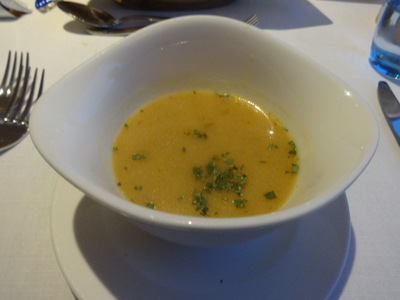
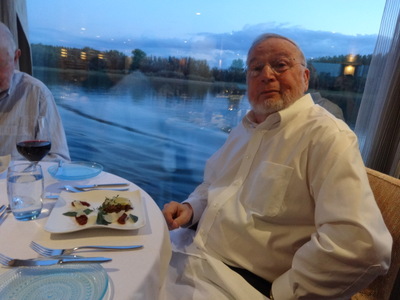 After the bus ride back to the ship at Nikopol, including that same 15-mile stretch of poorly maintained road, we were welcomed aboard with little glasses of "passionfruit lemonade"—what we would call passionfruit soda pop.
After the bus ride back to the ship at Nikopol, including that same 15-mile stretch of poorly maintained road, we were welcomed aboard with little glasses of "passionfruit lemonade"—what we would call passionfruit soda pop.
Once we had been escorted to our staterooms and had a little time to settled in, we went back upstairs to the lounge for the daily predinner briefing. Our tour director, Marek, welcomed us to the Danube, which is over 1700 miles long. We won't actually sail all of it, but we'll cover a good stretch, and he cheerfully informed us that, although we would see only 3 locks between Bucharest and Budapest, we would pass through 67 of them between Budapest and Amsterdam! On that note, he sent us off to dinner.
Here at the left is my Transylvanian sour soup, with chicken and corn broth.
David (at the right) chose the artichoke and mushroom tartare with sundried tomato, baby spinach, and flakes of Parmesan.
We passed up the roasted eggplant dip on garlic bread.
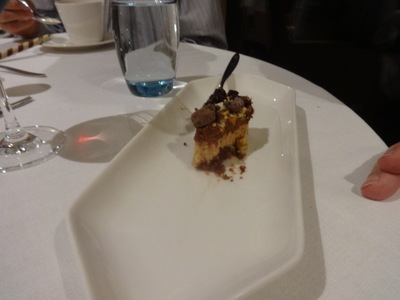 We both passed up the Gnocchi à la Niçooise and the Bulgarian spiced trout fillet for the whole roasted sirloin of beef with potato rosettes and cauliflower, but I forgot to photograph it. I think David had the balsamic pear cake with chocolate sauce and wheat crumble (shown here). I had the "kadaif," billed as Bulgarian baklava. It was very soft, moist baklava with very finely chopped nuts but topped with shredded kadaif pastry rather than whole sheets of phyllo. Pretty good.
We both passed up the Gnocchi à la Niçooise and the Bulgarian spiced trout fillet for the whole roasted sirloin of beef with potato rosettes and cauliflower, but I forgot to photograph it. I think David had the balsamic pear cake with chocolate sauce and wheat crumble (shown here). I had the "kadaif," billed as Bulgarian baklava. It was very soft, moist baklava with very finely chopped nuts but topped with shredded kadaif pastry rather than whole sheets of phyllo. Pretty good.